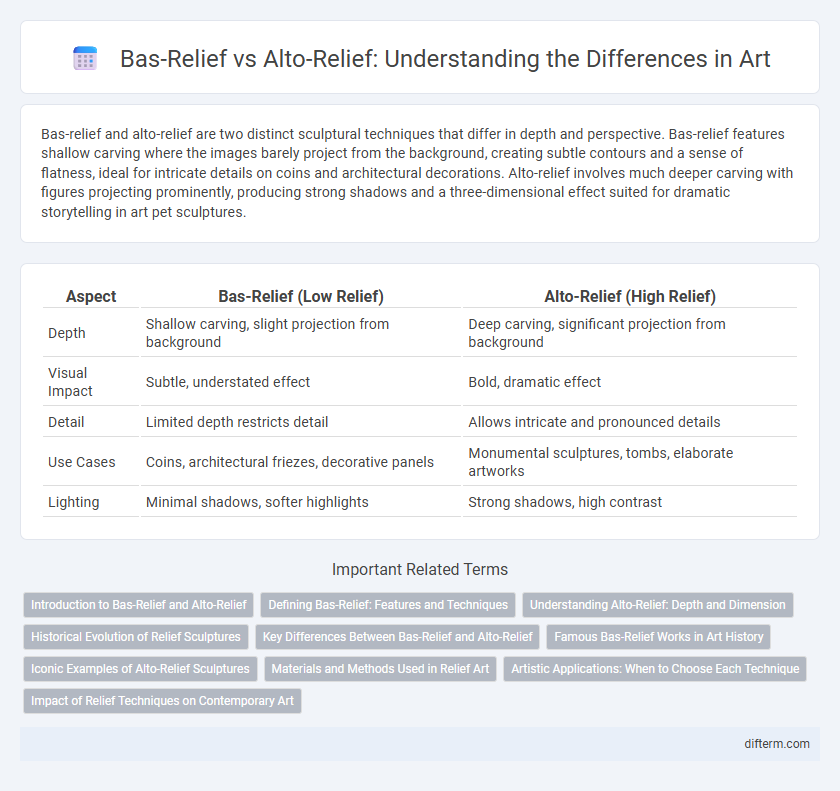Bas-relief and alto-relief are two distinct sculptural techniques that differ in depth and perspective. Bas-relief features shallow carving where the images barely project from the background, creating subtle contours and a sense of flatness, ideal for intricate details on coins and architectural decorations. Alto-relief involves much deeper carving with figures projecting prominently, producing strong shadows and a three-dimensional effect suited for dramatic storytelling in art pet sculptures.
Table of Comparison
| Aspect | Bas-Relief (Low Relief) | Alto-Relief (High Relief) |
|---|---|---|
| Depth | Shallow carving, slight projection from background | Deep carving, significant projection from background |
| Visual Impact | Subtle, understated effect | Bold, dramatic effect |
| Detail | Limited depth restricts detail | Allows intricate and pronounced details |
| Use Cases | Coins, architectural friezes, decorative panels | Monumental sculptures, tombs, elaborate artworks |
| Lighting | Minimal shadows, softer highlights | Strong shadows, high contrast |
Introduction to Bas-Relief and Alto-Relief
Bas-relief and alto-relief are sculptural techniques that vary primarily in the degree of projection from the background surface. Bas-relief features shallow depth with figures slightly raised, often seen in coins and architectural friezes, emphasizing subtle detail. Alto-relief presents a more pronounced three-dimensional effect where elements may be nearly or fully in the round, commonly used in monuments and stand-alone sculptures.
Defining Bas-Relief: Features and Techniques
Bas-relief is a sculptural technique where figures are slightly raised from a flat background, creating a subtle depth that emphasizes surface detail without full three-dimensional projection. This method employs shallow carving to highlight intricate textures and shadows, relying on precision and fine lines to convey form. In contrast to alto-relief, where elements extend prominently from the background, bas-relief maintains a delicate balance between flatness and depth, often used in architectural decoration and coin design.
Understanding Alto-Relief: Depth and Dimension
Alto-relief, also known as high relief, displays sculpted elements projecting significantly from the background, often extending more than half of their depth, creating a pronounced sense of depth and dimension. Unlike bas-relief, where figures are shallowly carved, alto-relief captures dramatic shadows and a three-dimensional effect that enhances visual impact and realism. This technique is commonly used in architectural decorations and monumental sculptures to convey dynamic movement and powerful narratives.
Historical Evolution of Relief Sculptures
Bas-relief and alto-relief represent distinct historical techniques in relief sculpture, with bas-relief featuring shallow depth that allows figures to slightly project from the background, prominently seen in ancient Egyptian and Mesopotamian art. Alto-relief displays a deeper, more pronounced projection, often used in classical Greek and Roman sculptures to enhance realism and dramatic effect. The evolution from bas-relief to alto-relief illustrates advancements in artistic skill and cultural emphasis on three-dimensionality throughout history.
Key Differences Between Bas-Relief and Alto-Relief
Bas-relief and alto-relief are two distinct sculptural techniques that differ primarily in the depth of their projection from the background. Bas-relief features shallow carving where figures slightly emerge from a flat surface, maintaining a subtle three-dimensional effect, while alto-relief displays deeper carving, allowing figures to project significantly and often appear almost fully in the round. These variations influence the visual impact and shadow play, with bas-relief commonly used for intricate narrative scenes and alto-relief emphasizing dramatic, lifelike forms.
Famous Bas-Relief Works in Art History
Famous bas-relief works in art history include the intricate panels of the Parthenon frieze, showcasing dynamic mythological scenes with shallow carving to enhance spatial depth. The Assyrian Palace reliefs from the Neo-Assyrian period demonstrate detailed narrative storytelling through low relief, emphasizing texture and pattern without deep excavation. These masterpieces contrast with alto-relief sculptures, where figures project more prominently, yet bas-relief maintains a refined subtlety ideal for architectural adornment and complex visual storytelling.
Iconic Examples of Alto-Relief Sculptures
Alto-relief sculptures are characterized by figures that project prominently from the background, often by more than half their depth, creating dramatic three-dimensional effects. Iconic examples include the Parthenon's East Pediment sculptures, where gods and mortals appear vividly lifelike, and the Assyrian Lamassu sculptures, which showcase intricate detail and dynamic presence. These masterpieces demonstrate the powerful visual impact and narrative depth achievable through alto-relief techniques compared to the subtler bas-relief style.
Materials and Methods Used in Relief Art
Bas-relief involves shallow carving on a flat surface, typically using materials like stone, plaster, or metal, where the design slightly projects from the background to create subtle depth. Alto-relief features a more pronounced projection, often exceeding half the depth of the background, commonly executed in marble, wood, or bronze for a dynamic, three-dimensional effect. Both techniques require specific tools such as chisels, gouges, and hammers, but alto-relief demands greater skill and precision due to its intricate depth and shadow interplay.
Artistic Applications: When to Choose Each Technique
Bas-relief is ideal for storytelling on flat surfaces, allowing subtle depth and intricate details without overwhelming the viewer, making it perfect for murals and architectural decorations. Alto-relief offers pronounced depth and dramatic shadows, enhancing the three-dimensional effect suitable for standalone sculptures and focal points where impact is crucial. Artists select bas-relief for narrative clarity and alto-relief for dynamic prominence in their compositions.
Impact of Relief Techniques on Contemporary Art
Bas-relief and alto-relief techniques distinctly influence contemporary art by shaping spatial perception and viewer interaction; bas-relief offers subtle depth that enhances architectural integration, while alto-relief provides dramatic protrusion, creating dynamic shadows and heightened tactile engagement. Contemporary artists leverage bas-relief's restrained dimensionality to merge art with environment, whereas alto-relief's pronounced relief fosters immersive narratives and sculptural prominence. These contrasting methodologies expand creative possibilities in public installations and gallery exhibitions through varied light interplay and textural complexity.
bas-relief vs alto-relief Infographic

 difterm.com
difterm.com